
Roman Gastronomy Uncovered: A Tour of Lazio’s Flavors
September 21, 2021
Explore Rome's rich culinary traditions, turning simple ingredients into gastronomic delights, ideal for food and wine enthusiasts.
By: Nicole Dickerson / Last updated: April 8, 2024
Estimated reading time: 15 minutes
Friuli-Venezia Giulia lies on the northeastern edge of Italy, bordered by Austria to the north, Slovenia to the east, the Adriatic Sea to the south, and the Veneto to the west. Throughout history, the region’s neighbors took a stab at staking their claim to the territory. Consequently, the Austrians, Slavs, Venetians, and even the Romans left their indelible mark on Friuli’s culture, cuisine, and customs.
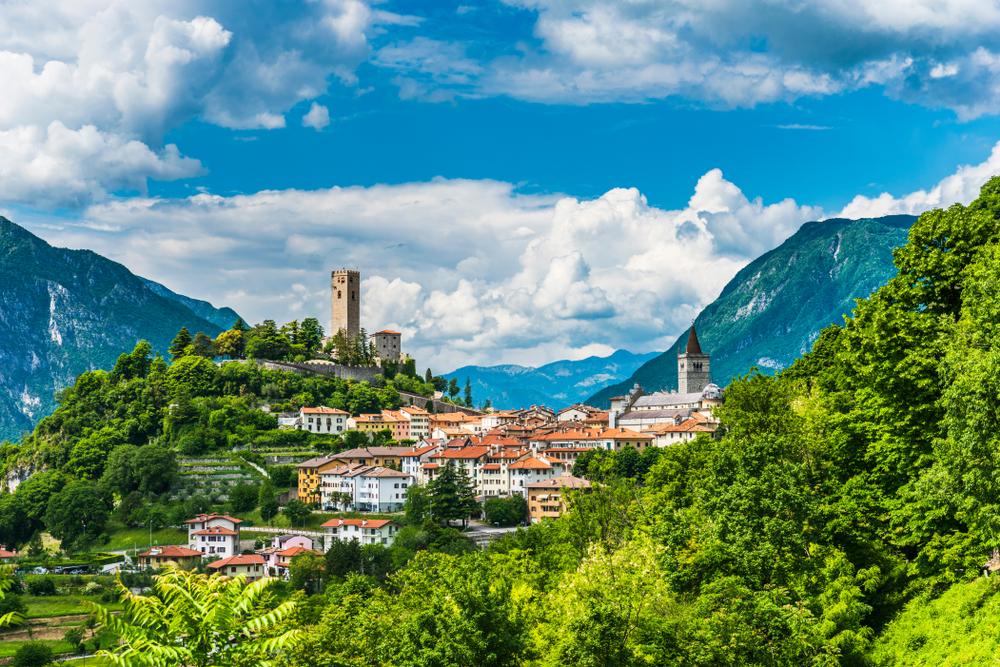
Guide to Italian Gastronomy and Cuisine: Read more
The region derives its name from Cividale del Friuli, a city on the Slovenian border that Julius Caesar founded circa 50 BC. In contrast, the Giulia portion of the name comes from the Julian Alps, a geographical landmark that influences the region’s cuisine along with the Carnian Alps. Furthermore, the Adriatic Sea provides a plethora of seafood to coastal zones like Trieste and Gorizia, as Friuli’s Tagliamento and Isonzo rivers offer abundant freshwater fish further inland. Consequently, Friulian cuisine combines Mediterranean flavors and mountain dishes influenced by neighboring Slovenian and Austrian traditions.
Friuli-Venezia Giulia is made up of four provinces. Pordenone and Udine are the two larger provinces encompassing the portion known as Friuli. In contrast, Gorizia and Trieste are much smaller and comprise the area of Venezia Giulia, which hugges the Adriatic coast in the east. Friuli-Venezia Giulia, often referred to as Friuli was formerly part of the Austro-Hungarian Empire before being incorporated into the Kingdom of Italy after the War of Independence in 1866.
The region tends towards cooler temperatures, so dishes are generally hearty and filling. Friulian cuisine features robust meat-based dishes, flavors from the Mediterranean Sea, and ingredients like horseradish reminiscent of the region’s Austro-Hungarian history. In Friuli, horseradish is called cren, and it’s either pickled or used to make a variety of sauces typically served with meat. Regardless of how cren is prepared, it always packs a flavorful punch.
Like other Italian regions, various cured meat specialties and cheeses are integral to the Friulian diet. In addition, regional cuisine incorporates similar seafood as neighboring Veneto, such as sardines, calamari, octopus, mussels, scallops, sea bass, anchovies, and freshwater fish like trout and carp.
Additionally, polenta is a staple in Friuli and is typically the carbohydrate of choice over rice and pasta. For produce unique to the region, try rosa di Gorizia, or “Gorizia’s rose,” a rare type of chicory known for its red color, rose-like shape, and milder flavor. Friuli also cultivates white asparagus, mainly in Udine, which was historically planted in vineyards to eliminate excess moisture in the soil.
For travelers interested in experiencing typical food products, gastronomy, and wines of Friuli, Ein Prosit is an annual festival dedicated to the food and wine of Friuli-Venezia Giulia. The event features guided tastings and cooking demonstrations in Tarvisio, Udine, and Malborghetto in mid-October. Also noteworthy is the annual festival of “Aria di Festa” celebrating San Daniele Prosciutto
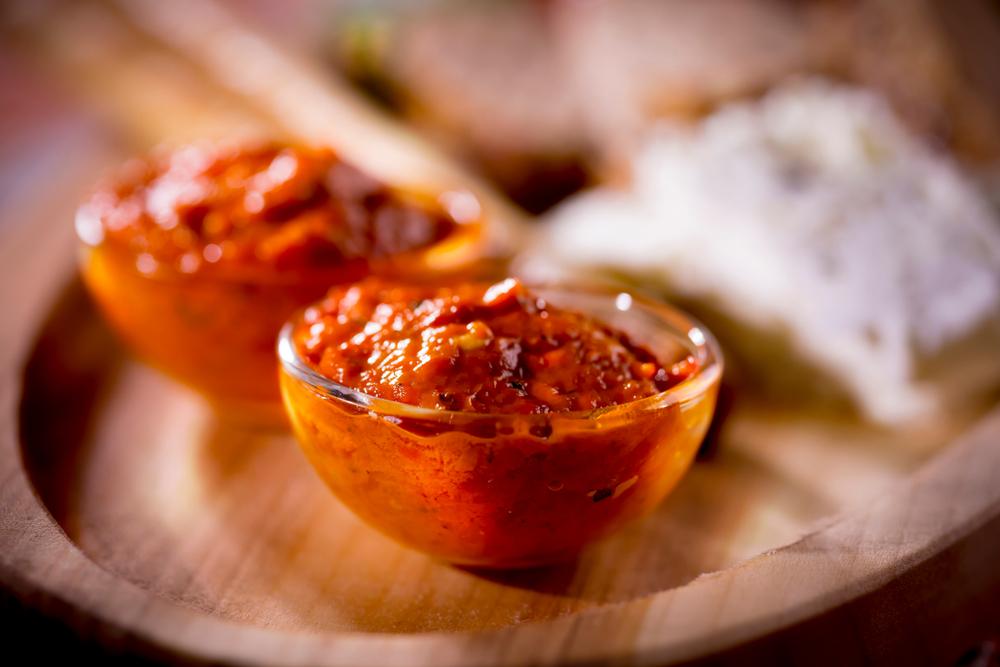
Before the Romans left their mark on Friuli, the Phoenicians planted olive groves in the region over 2,000 years ago. As a result, olive cultivation and olive oil have long been integral to the province’s agricultural trade, mainly in Trieste. The Tergeste DOP extra virgin olive oil is recognized among Italy’s top PDO-protected olive oils. According to the designation, 20% of olive groves for Tergeste DOP oil must be planted with Belica or Bianchera olive varieties. The remaining 80% can include Carbona, Leccino, Leccio del Corno, Frantoio, Maurino, and Pendolino varieties. This Friulian olive oil is known for its golden-green color and slightly piquant yet fruity flavor.
Acknowledged by the Slow Food Presidium, pestat di Fagagna was developed by local pork butchers, known as purcitâr, in the commune of Fagagna within Udine. It was created to conserve autumnal herbs and vegetable flavors in pork lard, akin to an old-school bouillon cube. Pestat di Fagagna is made by mixing ground lard with chopped carrots, onion, celery, sage, garlic, rosemary, and parsley. Then, the mixture is seasoned with salt, pepper, allspice, and cinnamon before being stuffed into a natural casing and left to age. Rather than eating pestat di Fagagna like a salami, it’s used as a base to flavor traditional dishes. Today, only two producers make this artisanal product.
With its origins in the Balkans, ajvar is a flavorful sauce made with charred red peppers, roasted eggplant, garlic, vinegar, and oil. In Friuli, the ingredients are blended to create a sauce for sausages, cold meats, or salami.
Though coffee culture abounds in Italy, Friuli is especially well-known for its high-quality brew. More specifically, Trieste is the region’s coffee epicenter, as its port regularly received coffee shipments on their way to Vienna, a famed mecca for coffee lovers since the seventeenth century. In addition, the renowned Illy Coffee has its headquarters in Trieste, and the city even developed its own cappuccino style, the Triestino served in an espresso glass with just a finger’s worth of frothy milk.
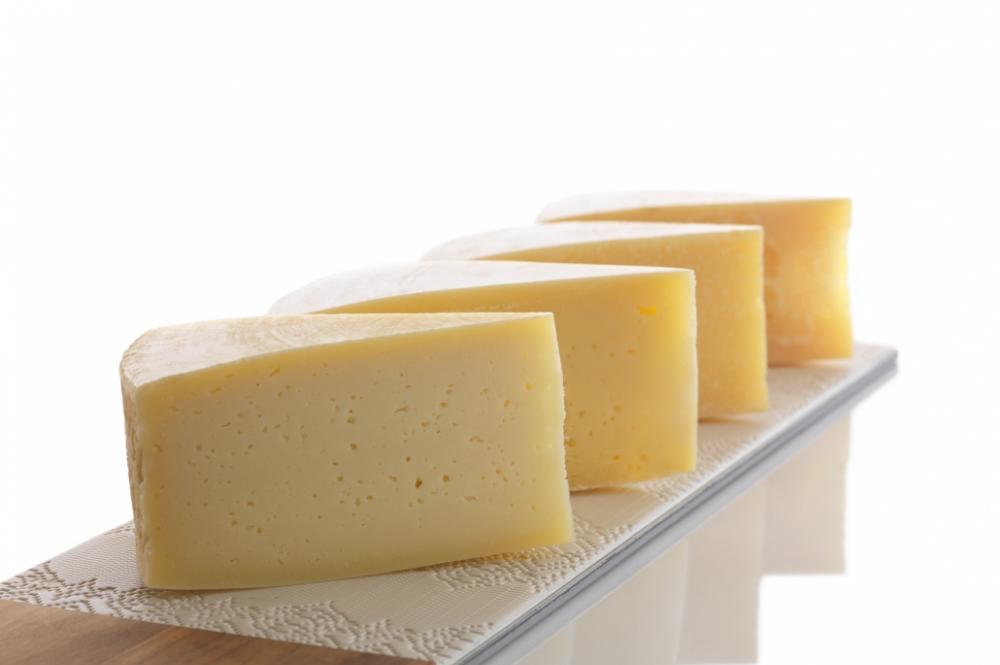
As with other alpine regions, mountainous Friuli is known for exceptional cheeses. Montasio DOP is one of the most prominent and produced mainly in Udine, Pordenone, and Gorizia. Montasio develops a crumpled texture and a more savory flavor with age. This semi-hard cow’s milk cheese, known for its delicate flavor and characterized by tiny holes throughout, is made in four different aged styles:
Another Friulian specialty recognized by the Slow Food Presidium, Formadi Frant, originated in the poor, peasant traditions of zero waste within Carnia in the province of Udine. It’s made by mixing offcuts of other cheeses deemed defective or unsuitable for aging. Hence, the name Formadi Frant means crushed cheese in Friulian. Formadi Frant varies from producer to producer but is generally known for its soft texture and slightly spicy flavor, thanks to black pepper.
In a small village near Trieste called Prepotto, you’ll find a local cheese called Jamar, made by dairyman Dario Zidaric. This cow’s milk cheese aged for a year in 60-meter-deep karst caves, resulting in intense flavors and a rich, creamy texture.
Next, malga is an alpine-style cheese from Carnia named for the alpine huts, or malghe, in which the cheese was originally produced. This cheese is made from cow’s milk and then ripens on wooden boards until it reaches a semi-hard texture with intense, grassy, and perhaps slightly bitter flavors.
Lastly, ciuncir is a cow’s milk ricotta, one of the oldest traditional cheeses from the Friulian mountains. It’s only aged 45-60 days and is highly aromatic due to the addition of cumin, which grows in mountain pastures.
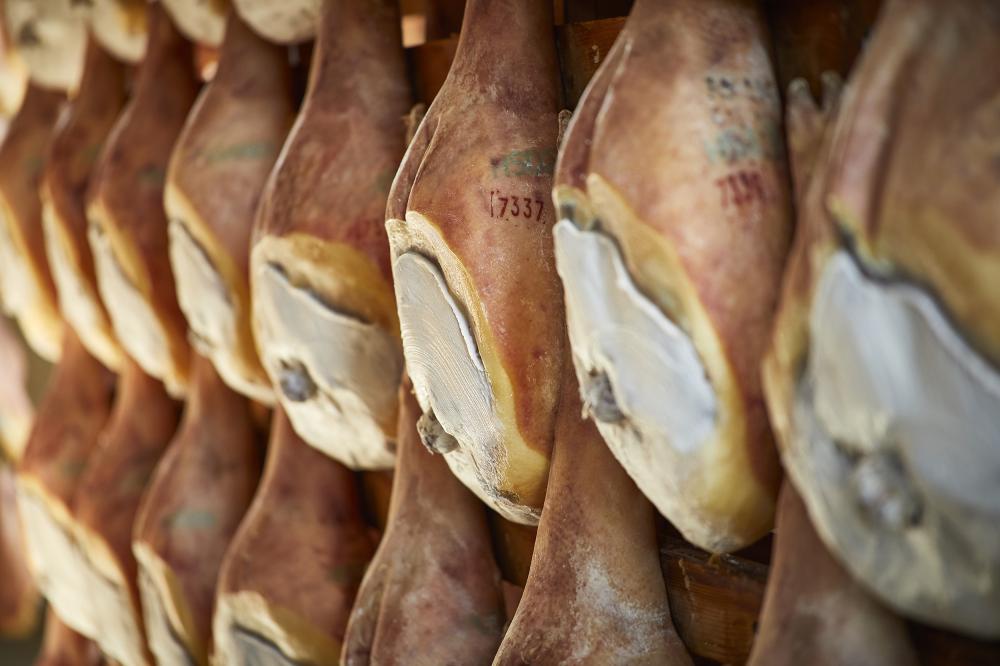
Prosciutto di San Daniele DOP is amongst Friuli’s most distinguished food products. Its trademark flavor has been created through the same artisanal process for centuries:
After a four-month rest, they’re washed and left to cure until at least the thirteenth month. Finally, any exposed meat part is greased with a mixture of lard and rice or wheat flour to protect and tenderize the ham. The result is rosy-red colored prosciutto with delicate aromas and flavors of dried fruits, barley malt, and crusty bread.
Beyond prosciutto di San Daniele, be sure to try a smoked ham made in the Carnian Alps called speck di Sauris. This speck has a stronger taste thanks to its garlic, salt, and pepper seasoning, creating a spicy flavor. Plus, the ham is cured with beechwood smoke, further enhancing flavor and making it slightly tougher.
Additionally, Friulians enjoy muset, a sausage made from pork offal spiced with black pepper, coriander, cloves, nutmeg, and cinnamon. Like cotechino, it’s usually eaten boiled in winter as it’s pretty fatty.
Originating in the Val Tramontina mountain area, pitina is a giant meatball made of smoked chamois or goat meat. Seasoned with salt, pepper, garlic, and red wine, pitina can also be enriched with pork meat or lard. The mixture is shaped into a ball, rolled in cornflour, and then smoked with pine, resulting in an intense flavor. Pitina is eaten raw or grilled and served with polenta.
Finally, considering the freshwater lakes and rivers throughout Friuli-Venezia Giulia, smoked trout is also a specialty of the region.
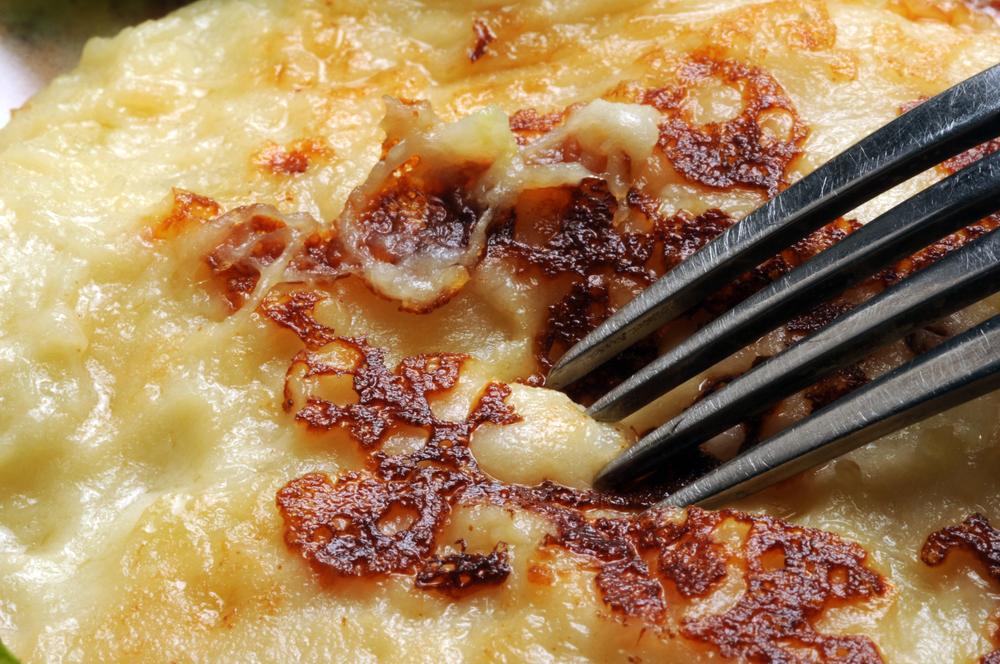
Frico is a potato, onion, and cheese pancake born in Friulian peasant kitchens and created to utilize leftover cheese scraps, usually from Montasio cheese. Grated potatoes, onions, and shredded Montasio cheese are cooked like a frittata until a golden-brown exterior forms with a soft, gooey interior. There’s also a more straightforward, crunchy version called frico croccante, which involves frying shredded cheese in hot oil. Frico is served hot as an appetizer or alongside polenta, soups, or stews for a hearty main course. Today, variations on the original recipe might include pancetta, mushrooms, tomatoes, herbs, or other vegetables.
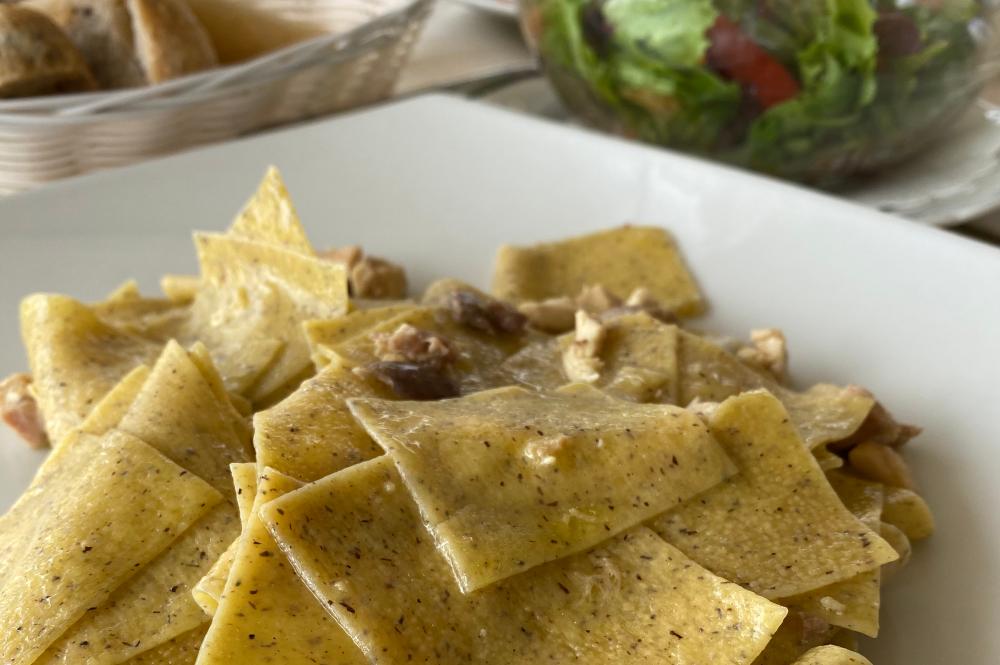
Both sweet and savory versions of strucolo, Friuli’s take on Austrian strudel, are enjoyed in the region. In either case, strucolo features a roll of dough stuffed with some filling variation. Savory strucolo is served as a primo piatto, or first course, and contains just about anything. Typical fillings include ricotta, spinach, peas, minced veal, or beef. If not baked, strucolo is rolled, tied on the ends with thread, and boiled. They may be served seasoned with melted butter and breadcrumbs or cheese. In contrast, strucolo di pomi is a popular sweet version similar to apple strudel.
Popular in Trieste, jota is a winter staple in Friulian cuisine, as this comforting stew of beans, potatoes, and tangy sauerkraut is ideal for warming up when temperatures drop. The beans and sauerkraut, known locally as capuzi garbi, are cooked with cumin, bay leaves, potatoes, and pancetta to make this thick soup. Jota exemplifies the Austrian influence on food in Friuli.
Another traditional soup of Friuli-Venezia Giulia, ideal for cooler months, is paparot, made from spinach, cornmeal, flour, garlic, and other seasonings. To prepare paparot, the butter, flour, and garlic are first sautéed with salt and pepper. Next, boiled spinach is added, along with water. Once the soup starts to boil, the polenta is added and frequently stirred. Finally, adding sausage or lard can make the soup even heartier.
Especially prominent in Trieste yet enjoyed throughout Friuli, gnocchi di prugne are plum-filled potato dumplings popular in regions once ruled by the Austro-Hungarian empire. They can be served as dessert, though gnocchi di prugne is often presented as a primo piatto in Friuli. When in season, the salted gnocchi dough is stuffed with prunes or tart plums and a mixture of breadcrumbs toasted in butter with sugar and cinnamon. Once boiled in salted water, the gnocchi is seasoned with melted butter and toasted breadcrumbs. As a result, gnocchi di prugne offers a surprisingly delicious sweet and savory dish. During the summer months, you’ll also find a version filled with cherries in the northeastern part of the region.
Also known as cialzons, cjarsons are a filled pasta resembling ravioli and are a signature dish of the Carnia region. Potatoes are used to make the pasta dough, filled with ricotta and an array of potential ingredients, including dried fruits, apples, spices, aromatic herbs, and more. Recipes vary by household and region, with numerous sweet and savory versions. For example, cialzons della Val Gortono is made with only flour and water, plus a filling of milk-soaked bread, onions, butter, parsley, fresh ricotta cheese, and grappa. In comparison, cialzons near Arta Terme are considered a dolce, as they’re filled with apples, pears, mint, basil, prunes, chocolate, and biscuits. Traditionally, cjarsons are topped with melted butter and grated smoked ricotta.
I girini a Friulian pasta made similarly as spätzle Tirolesi in Trentino Alto-Adige. These tiny, twisted pieces of pasta are made from an egg and flour dough pressed through a potato ricer or colander and then boiled to cook. I girini are often served with seasonal greens or other ingredients like prosciutto di San Daniele, Gorizia’s rose chicory, zucchini, and goat cheese.
Blecs, or biechi, is a pasta unique to Friuli, traditionally made with wheat and buckwheat flour. Today, regular white flour is typically used. Blecs are known for their flat triangle or square shape and are often served with rich butter and Montasio cheese sauce.
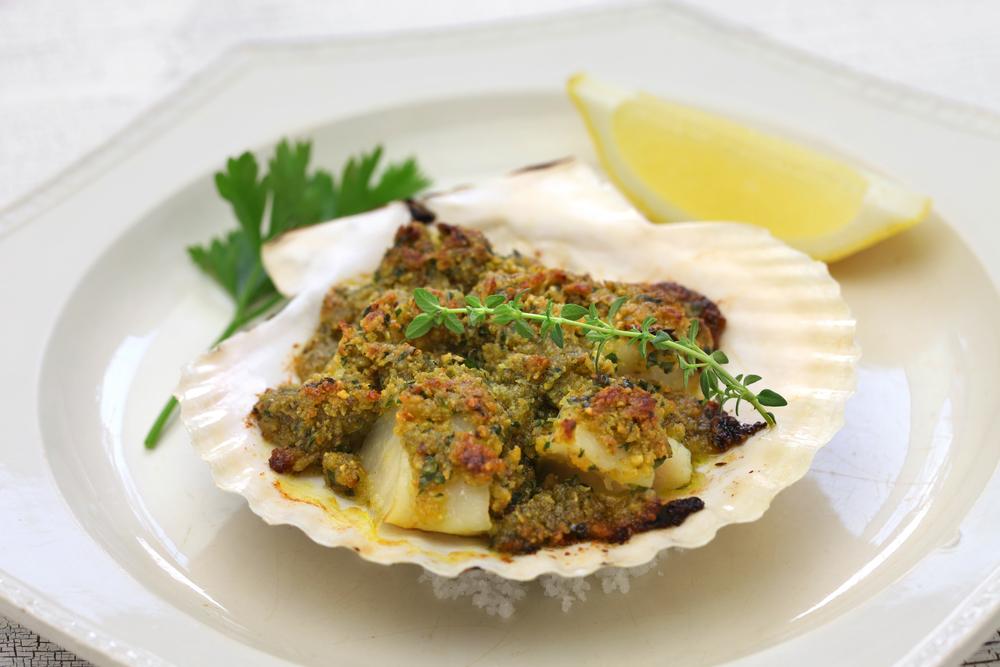
Brovada and muset is a dish with ancient origins dating back over 2,000 years, still serving as a Christmas specialty today. Friulians would place turnips in vats to preserve them over winter, covering them in black grape pomace, salt, and water mixed with wine or vinegar. The turnips ferment over a forty-to-sixty-day period; then, they’re washed and grated, resulting in a product known as brovada. Today, brovada has a DOP-protected status. It’s often served with meats, such as the regional specialty brovada and muset. This classic dish sees boiled muset cooked with brovada, garlic, bay leaves, and vegetable stock.
Capesante gratinate is a seafood specialty in Trieste made with fresh scallops plucked from the Adriatic Sea. The scallops are dressed in butter, parsley, onion, and breadcrumbs and then baked in their shells.
Goulash Triestino is from Trieste, the capital of Friuli-Venezia Giulia and formerly part of the Austro-Hungarian Empire. Consequently, Hungarian paprika flavors the dish made with slow-cooked beef simmered with onions, tomatoes, tomato paste, olive oil, Italian herbs, and a pinch of flour. Polenta, potatoes, or gnocchi typically accompany goulash Triestino.
In Friuli, il bollito is a flavorful yet straightforward boiled meat dish featuring different pig parts, such as its ears, tongue, head, pancetta, and knuckles. A spicy salami called porcina, sausages, and other ingredients are added to the boil, too. Il bollito is served hot, accompanied by sauerkraut, grated horseradish, and mustard.
A Friulian specialty inherited from the Balkans, cevapčići is a cross between kebabs and sausages. It’s made from mixed minced beef and lamb meat seasoned with garlic, onion, paprika, white wine, and olive oil. The latter helps the meat remain tender while grilling. Cevapčići is served with ajvar sauce for an authentic taste of the Balkans in Friuli.
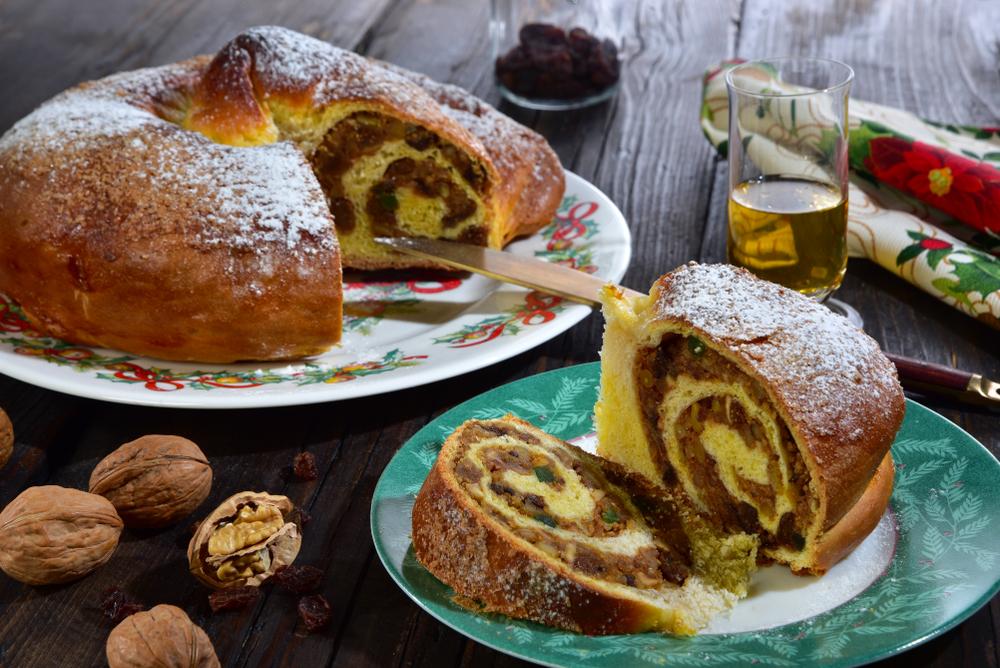
Adored in Trieste and Gorizia, presnitz is a coiled spiral of puff pastry dough filled with dried fruits, nuts, citrus peel, cinnamon, and rum. It’s baked and then sprinkled with powdered sugar for a heartwarming dessert. Presnitz originally hails from Castagnevizza, a Slovenian town just over the border from Italy.
Traditionally prepared for holidays but now enjoyed throughout the year, gubana is a leavened sweet bread filled with dried or candied fruits and walnuts. Legend has it that a poor woman from Cividale had nothing to sweeten the bread, so she used honey and walnuts.
These treats feature a sweet nut-based filling between two thin layers of dough. Popular around Carnival or Christmas, strucchi are boiled or fried, then dusted with powdered sugar.
Friuli-Venezia is bordered by Slovenia and Austria and is known for its diverse vineyards. Some vineyards in western Primorska, though politically part of Slovenia, are geographically in Friuli. This region boasts four DOCG appellations, over 10 DOCs, and three IGPs, with a wide range of microclimates and terroirs, resulting in various wine styles. While white wine production dominates, warm sites allow for the ripening of red varieties like Cabernet Sauvignon. Colli Orientali in the east has a cool continental climate with mineral-rich soils, while Isonzo in the south enjoys a milder climate, particularly suitable for Merlot. However, wines from the flatter Isonzo areas can vary in quality.
If you would like us to customize an exclusive luxury tour, contact us and let us know your travel plans. We offer luxury food and wine tours for private groups of a minimum two guests. In addition, all of our private, chauffeured tours are available year-round upon request.

